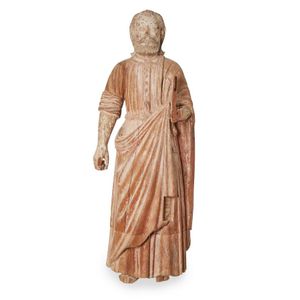Secarel's Huddled Man with Fruit Basket
You must be a subscriber, and be logged in to view price and dealer details.
Subscribe Now to view actual auction price for this item
When you subscribe, you have the option of setting the currency in which to display prices to $Au, $US, $NZ or Stg.
- Bronze - An alloy of copper and tin, traditionally in the proportions of about 9 parts of copper to 1 part of tin.
The discovery of bronze in Western Asia in the 4th century enabled people to create metal objects which were superior to those previoulsy possible because of its strength and hardness, and it has been used throughout the world for weapons, coins, tools, statuary and other decorative items.
It is very fluid in a molten state, and its hardness, strength when set, and non-corrosive properties makes it most suitable for casting sculpture. - Circa - A Latin term meaning 'about', often used in the antique trade to give an approximate date for the piece, usually considered to be five years on either side of the circa year. Thus, circa 1900 means the piece was made about 1900, probably between 1895 and 1905. The expression is sometimes abbreviated to c.1900.
- Ivory - Ivory is a hard white material that comes from the tusks of elephants, mammoth, walrus and boar, or from the teeth of hippopotamus and whales. The ivory from the African elephant is the most prized source of ivory. Although the mammoth is extinct, tusks are still being unearthed in Russia and offered for sale.
Ivory has been used since the earliest times as a material for sculpture of small items, both in Europe and the east, principally China and Japan.
In Asia ivory has been carved for netsuke, seals, okimono, card cases, fan supports, animals and other figures and even as carved tusks.
In the last 200 years in Europe ivory has been used to carve figures, for elaborate tankards, snuff boxes, cane handles, embroidery and sewing accessories, in jewellery and as inlay on furniture. Its more practical uses include being used for billiard balls, buttons, and a veneers on the top of piano keys.
The use and trade of elephant ivory have become controversial because they have contributed to Due to the decline in elephant populations because of the trade in ivory, the Asian elephant was placed on Appendix One of the Convention on International Trade in Endangered Species (CITES), in 1975, and in January 1990, the African elephant was similarly listed. Under Appendix One, international trade in Asian or African elephant ivory between member countries is forbidden. Unlike trade in elephant tusks, trade in mammoth tusks is legal.
Since the invention of plastics, there have been many attempts to create an artificial ivory
This item has been included into following indexes:
Visually similar items

A large Hispano Philippine carved wood figure of a Saint, probably Goan 17th/18th century, Depicted in robes holding the book in one arm and possibly keys in the other (now with loss), 105 cm high. Condition: the wood is very dense and heavy and has the gr

An ocelot fur coat, label for Cornelius Sydney 112 cm long

Vintage three quarter length mink fur coat, 6 double breasted buttons and fold back collar

A Mink fur jacket by Hodders Adelaide, labelled 'Hodders' 15 Adelaide arcade, Adelaide, having bell sleeves and a notched collar, centre back length 67 cm
